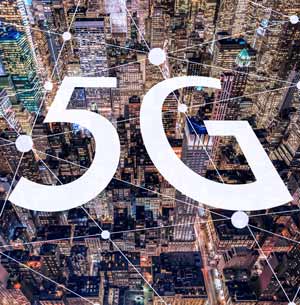
In the past five years, the amount of data being generated, consumed, transferred, and stored was massive. 5G is expected to bring an unforeseen level of network abilities and data transfer rates that will set the stage for even more advanced and novel applications to have everything more connected, in real time, all the time.
5G Market Situation
With exponential increases in connected devices, data traffic and edge to core architecture, there will be 422 million 5G connections globally, and 77.5 EB (exabytes) of mobile data traffic per month, which is equivalent to 930 EB a year, by 2022.[1]
Total global CapEx is expected to reach $88 billion worldwide by 2023, bringing global 5G rollouts in full swing.[2]The two key technology catalysts, efficiency and scale, enabled by 5G’s network virtualization and network slicing capabilities, will allow future 5G service providers to drive and facilitate new applications and services in other markets beyond mobile.
In fact, the 5G-enabled revenue across eight key sectors (financial services, automotive, public transport, media and entertainment, healthcare, energy utilities, manufacturing, and public safety) will be worth approximately $3.3 trillion USD in 2026, a significant increase from the $1.7 trillion USD generated from basic mobile subscriptions and mobile data services.[3]
Data traffic will grow at a much faster rate than the number of 5G connections
The revenue increase comes from the M2M (machine-to-machine) IP traffic which will grow to more than 25 EB by 2022 accounting for 6% of global IP traffic.[4] Increases in 4K to 8K video applications and new use cases requiring higher bandwidth and lower latency will cause data traffic to grow at a much faster rate than the number of 5G connections.
Challenges: Complexity and Speed of Data
Today’s challenges with data are heterogeneous. Data is scattered and unstructured in mixed environments – endpoints, edge, on-premise, cloud, or a hybrid. Data is also accessible across different architectures, including file-based, database, object, and containers. There are also issues of duplications and conflicts of data.

5G will surely add more complexity to today’s existing challenges. With 5G, even more data will be generated from endpoints and IoT devices, with more metadata and contextual data produced and consumed. As a result, there will be more demand for real-time processing and more edge compute processing, analyzing, and data storage scattered throughout the network.
What is Your Data Strategy?
Applications and use cases are unique and have different storage requirements and challenges, including performance, integrity of data, workloads, retention of data, and environmental restrictions. In the past, the capabilities of general-purpose storage greatly exceeded the requirements of networks, data, and applications. Now, with the insurgence of endpoints, edge computing, and cloud computing, storage has to meet advanced use cases and environment demands that general-purpose storage is not suited for. With the move to 5G, companies will need to re-think and architect which data they want to capture, process and keep through the new continuum of end points, edge compute and cloud.
5 Edge Computing Design Considerations: Storage
Today and in the new 5G era, storage has to anticipate and meet the conditions and expectations of various use cases, workloads, and environments. To create an environment for data to thrive, there are five key edge design considerations for storage which I recently described at The Big 5G Event in Colorado:
1. Environmental:
In what kind of environment will the data be captured and kept? The most critical environmental conditions that can affect storage performance are altitude, temperature, humidity, and vibration. For example, a smart car outside in the desert heat or during a snowstorm will need to withstand extreme temperatures. Sensors in the mountains or a highspeed train in Japan will need to be resistance to pressure and movement.
2. Endurance and Workload:
How many times can you write to the storage? Is your application write-intensive, such as video recording for surveillance, or read-intensive, such as map and music from the car infotainment system? Is your equipment in a hard-to-reach place, such as a video surveillance camera at the top of a building, or behind the secured doors of a bank vault? In these scenarios, a high endurance storage solution will help limit the frequency of maintenance and replacement.
3. Data Retention:
How long does the data need to be stored? What do you want to process, analyze and save at the endpoints, at the edge, and in the cloud? For example, a corporate database may require documents to be stored electronically for five years or longer. Specific data may also be retained for future analytics. The storage solution needs to meet the data retention policy and capacities required for various applications/use cases and regulation.
4. Monitoring:
How is the data monitored? Who has access to the data collected? How good is the data? With rapid increases in the number of connected devices and edge compute deployments, and the complexity of data being generated, people want to have access to the data at all times. Having the ability to monitor both the health of the storage device as well as the health of the data is becoming more important to users these days to ensure data integrity and cost management.
5. Security:
How will the data be protected? Typically, data is secured on the host side (CPU), but hosts can be susceptible to tampering. More and more applications expect for data also to be secured on the data storage device itself through encryption at rest.
Defining Edge Computing Design from the Endpoints
5G is going to be fast, and it will bring in new, extreme use cases. We need to think differently about edge computing and storage design and optimized architectures. Without clearly defining storage from the endpoints, through edge and cloud looking at both user and application needs, 5G and future environments will not rise to their full potential.
Learn more about how we’re powering a 5G world.
[1]https://www.cisco.com/c/m/en_us/solutions/service-provider/forecast-highlights-mobile.html
[2]http://www.heavyreading.com/details.asp?sku_id=3568&skuitem_itemid=1789&_ga=2.242504897.27752799.1556138244-1150791651.1551207551
[3]http://www.5gamericas.org/files/7114/9971/4226/Ericsson_The_5G_Business_Potential.pdf
[4]https://www.cisco.com/c/en/us/solutions/collateral/service-provider/visual-networking-index-vni/white-paper-c11-738429.html







